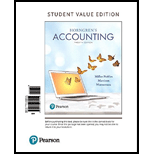
Concept explainers
Which of the following benefits of an effective
Learning Objective 1
a Flexibility
b. Relevance
c. Control
d. Compatibility
An Accounting Information System (AIS) is a process which collects data, processes the same into information, and distributes it to users. It is a tool which helps smoother decision making. The purpose of an accounting information system (AIS) is to collect, store, and process financial and accounting data and produce informational reports.
To determine:
Which benefit of the effective accounting information system provides safeguards for business assets and reduces the likelihood of fraud and errors?
Answer to Problem 1QC
Solution:
C. Control
Explanation of Solution
Explanations:
Given: Following choices are given:
a. Flexibility
b. Relevance
c. Control
d. Compatibility
Control assures that internal processes and procedures are implemented according to the standards set by the management. It Creates structure and encourages adherence to management procedures. Detects errors and frauds and also reduces chances of frauds and errors which may occur in future.
Objectives of Control: To safeguard the assets of the organization, to maintain records, to provide accurate & reliable information whenever required, to promote & improve operational efficiency, to encourage adherence to prescribed policies, to comply with applicable laws & regulations and to detect errors and frauds.
Other benefits of accounting information system serve for following:
Flexibility: Facilitates the business to accommodate with the changes madein the business over time or contingencies which may occur in future.
Relevance: It refers to the relation of the information with the subject matter. It saves time by reducing irrelevant information.
Compatibility: It facilitates compatibility between employees and structure of the organization.
Thus, among all the given benefits of the effective accounting information system, CONTROL provides safeguards for business assets and reduces the likelihood of fraud and errors.
Want to see more full solutions like this?
Chapter 7 Solutions
Horngren's Accounting, Student Value Edition (12th Edition)
Additional Business Textbook Solutions
Principles of Economics (MindTap Course List)
MARKETING:REAL PEOPLE,REAL CHOICES
Management (14th Edition)
Horngren's Cost Accounting: A Managerial Emphasis (16th Edition)
Financial Accounting: Tools for Business Decision Making, 8th Edition
- I need help finding the correct solution to this financial accounting problem with valid methods.arrow_forwardCan you help me solve this general accounting problem with the correct methodology?arrow_forwardI need help with this financial accounting problem using proper accounting guidelines.arrow_forward
- Please provide the solution to this general accounting question using proper accounting principles.arrow_forwardI need help finding the accurate solution to this general accounting problem with valid methods.arrow_forwardWhen incorporating his sole proprietorship, Joe transfers all of its assets and liabilities. Included in the $30,000 of liabilities assumed by the corporation is $500 that relates to a personal expenditure. Under these circumstances, the entire $30,000 will be treated as boot. / Provide explanation please a. True b. Falsearrow_forward
- In determining whether § 357(c) applies, assess whether the liabilities involved exceed the bases of all assets a shareholder transfers to the corporation./ Provide explanation please. a. True b. Falsearrow_forwardI will unhelpful if wrong.arrow_forwardplease don't solve using wrong values i will mark as unhelpful.arrow_forward
 Auditing: A Risk Based-Approach to Conducting a Q...AccountingISBN:9781305080577Author:Karla M Johnstone, Audrey A. Gramling, Larry E. RittenbergPublisher:South-Western College Pub
Auditing: A Risk Based-Approach to Conducting a Q...AccountingISBN:9781305080577Author:Karla M Johnstone, Audrey A. Gramling, Larry E. RittenbergPublisher:South-Western College Pub Auditing: A Risk Based-Approach (MindTap Course L...AccountingISBN:9781337619455Author:Karla M Johnstone, Audrey A. Gramling, Larry E. RittenbergPublisher:Cengage LearningPrinciples of Accounting Volume 2AccountingISBN:9781947172609Author:OpenStaxPublisher:OpenStax College
Auditing: A Risk Based-Approach (MindTap Course L...AccountingISBN:9781337619455Author:Karla M Johnstone, Audrey A. Gramling, Larry E. RittenbergPublisher:Cengage LearningPrinciples of Accounting Volume 2AccountingISBN:9781947172609Author:OpenStaxPublisher:OpenStax College- Principles of Accounting Volume 1AccountingISBN:9781947172685Author:OpenStaxPublisher:OpenStax College
 Accounting Information SystemsAccountingISBN:9781337619202Author:Hall, James A.Publisher:Cengage Learning,
Accounting Information SystemsAccountingISBN:9781337619202Author:Hall, James A.Publisher:Cengage Learning, Cornerstones of Financial AccountingAccountingISBN:9781337690881Author:Jay Rich, Jeff JonesPublisher:Cengage Learning
Cornerstones of Financial AccountingAccountingISBN:9781337690881Author:Jay Rich, Jeff JonesPublisher:Cengage Learning





